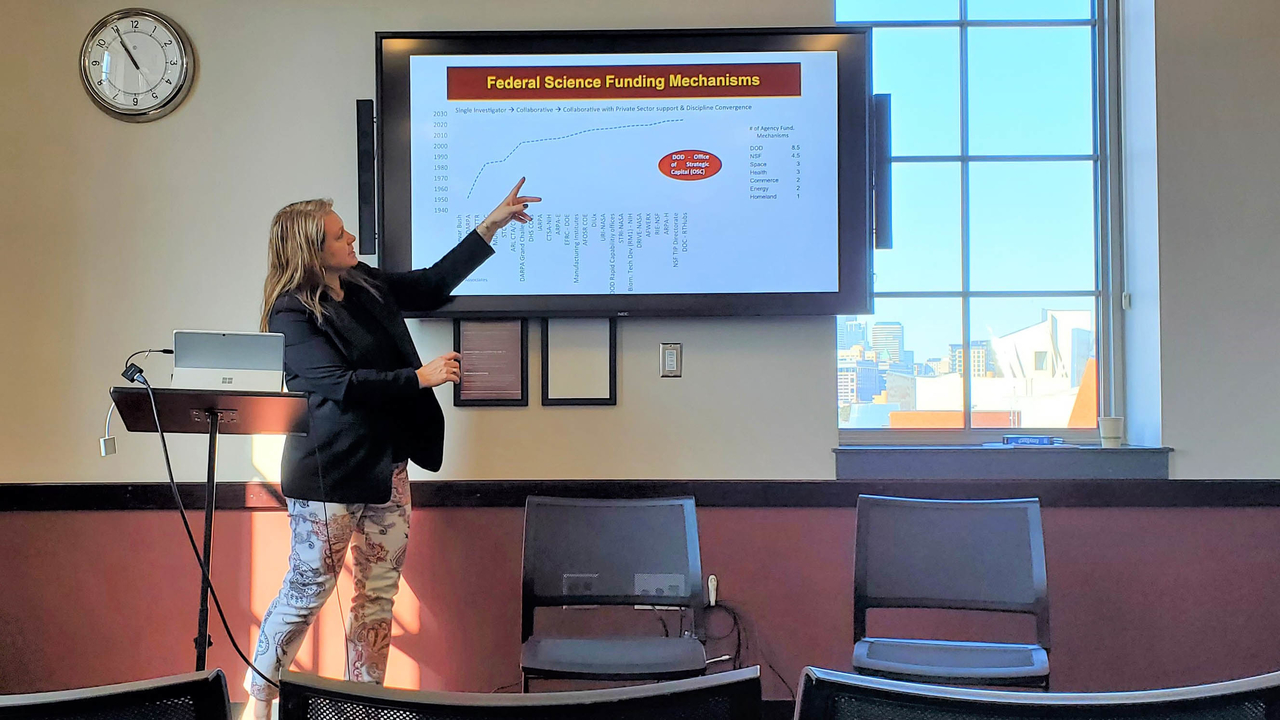
AVP Amy Kircher provides an overview of federal science funding mechanisms.
Federal agencies are the largest source of research grants at the University of Minnesota. In FY22, federal funding comprised approximately 60 percent of all award funding, and about two-thirds of that federal funding comes from the National Institutes of Health (NIH) and the National Science Foundation (NSF). And while many UMN researchers seek funding from NIH and NSF, there are a lot of opportunities outside of these agencies that are worth pursuing.
A session at the March 24 Speaking Science Conference, "Beyond NIH & NSF: Finding and Talking to Mission-Oriented Agencies for your Research," facilitated by Amy Kircher, associate vice president for research, and Katey Pelican, director of Strategic Partnerships and Research Collaborative (SPARC), provided an overview of how to effectively partner with and get funding from mission driven agencies such as the Department of Defense, Department of Energy, USAID, and private foundations. Here are a few key takeaways from the presentation.
Know Your Audience
Mission driven organizations have very specific funding priorities based on real-world problems, such as climate change, global pandemics, and food security. To be successful, it's essential that researchers directly address the funders' priorities and make a strong case for how their own research project will help advance the mission.
"The primary goal [for these organizations] is not research, but to advance their missions," said Kircher. "Know your audience and write against that"
Researchers should closely read the request for proposal (RFP) and carefully align their own narrative to it, even using the exact language in the proposal in some cases. One of the biggest mistakes researchers make, said Pelican, is to NOT pay attention to the language in the RFP.
"Each agency has its own language, focus, and culture," said Pelican. "Learn the agency's language and match it."
Develop a Strategy
Taking the time to develop a research strategy will go a long way in helping to identify the right research partners and successfully get funding for projects.
"It's important to know who funds your work and to follow their research and technology priorities," said Kircher.
Kircher suggested a range of tactics. Follow agencies on social media, sign up for funding announcements, track their priorities, and attend conferences where their program officers are speaking or attending. Newer faculty with minimal contacts might consider aligning with a more seasoned faculty member on a research project in order to build those relationships and a research portfolio.
Another part of the strategy is for researchers to assess the impact of their research based on current events (now and in the future). The political climate and other factors may influence either an increase or decrease in the availability of funding. For example, gun control is a hotly contested political issue, so it's less likely to get funded during a divided government. At the same time, Kircher noted that in the most recent budget, the Department of Defense (DoD) was funded beyond what the Biden administration requested. And she pointed out that "there is a whole complement of work that DoD funds that is not fighting the nation's wars."
Be Ready
Kircher and Pelican stressed the importance of having a "white paper" or slide deck about the research ready to go at all times. Government agencies sometimes have money left in their budgets at the end of the fiscal year, and rather than do a formal RFP, they will request white papers for quick turnaround opportunities to fund. These documents should not be too technical and they should directly address how the research will benefit the mission.
"It's important to sell yourself and what you have to offer,” said Pelican. "The government will be grateful for partners who can help them."
Pandemics, natural disasters, and social/political crises are devastating for our communities, but they are also just-in-time opportunities for researchers who are able to respond quickly with solutions that can help, such as during the recent COVID-19 pandemic. While no one wishes to have a global crisis, academic institutions are often well positioned to provide needed knowledge and expertise during these events.
Small Things Matter
Part of the presentation involved a detailed walk-through of developing a mission-based proposal. Before writing anything, they recommend creating a detailed outline that incorporates all of the RFP headings, key words, and anything that is required or strongly advised to include in the proposal. While the process is painstaking, it ensures that everything important to the funder is captured and highlighted. It forces the researcher to pay attention to and respond to the agency's specific language and priorities.
One final tip is for researchers to take the time to get to know and build strong relationships with their grant coordinators and administrative support staff, including contacts at Sponsored Projects Administration. If the administrative staff who help to process proposals know and have a good working relationship with the researcher, they are more likely to go the extra mile, such as to help expedite last minute requests.